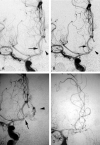Abciximab in patients with ruptured intracranial aneurysms
- PMID: 16091524
- PMCID: PMC7975173
Abciximab in patients with ruptured intracranial aneurysms
Abstract
Background and purpose: Experience with intravenous abciximab to manage thromboembolism during treatment of ruptured intracranial aneurysms is limited. We present our experience in 13 patients.
Methods: We retrospectively reviewed all patients with thromboembolic complications during endovascular management of ruptured intracranial aneurysms. Thromboembolic complications were treated with intravenous abciximab. We recorded patient and aneurysm demographics, aneurysm occlusion, drug therapy, complications, and outcomes.
Results: World Federation of Neurological Surgeons Grades were 1 or 2 in 11 patients (85%). Median time from diagnostic angiography to treatment was 1 day. Ten (77%) aneurysms involved the anterior or posterior communicating artery, and one each occurred in the posterior inferior cerebellar artery, middle cerebral artery, and basilar regions. Eleven aneurysms were <10 mm. Five were incompletely occluded (0%-90% treated) at the time of the complication. Thromboembolic complications were at the coil-ball/parent-artery interface in nine patients (69%). Two were associated with coil-loop prolapse; one was prophylactically treated without evidence of thromboembolism. Five patients (38%) had distal complications; one also had a proximal thrombus. All patients received an intravenous bolus of abciximab (5-10 mg in 92%) without infusion. Postprocedural recanalization was complete in eight (62%) and partial in four (31%). Eleven patients (85%) had a Glasgow Outcome Scale score of 1 at 3 months. One had a poor outcome (GOS4). One died following additional coiling after abciximab administration, though this intervention was uneventful in three others.
Conclusion: Abciximab completely or partially treated thromboembolic complications arising during coiling of ruptured aneurysms. Further coiling should be performed with extreme caution and needs to be decided on a patient-by-patient basis.
Figures


Comment in
-
Platelet receptors.AJNR Am J Neuroradiol. 2006 Jan;27(1):8-9; author reply 9. AJNR Am J Neuroradiol. 2006. PMID: 16418346 Free PMC article. No abstract available.
Similar articles
-
Safety of Abciximab injection during endovascular treatment of ruptured aneurysms.Interv Neuroradiol. 2015 Jun;21(3):332-6. doi: 10.1177/1591019915582001. Epub 2015 May 11. Interv Neuroradiol. 2015. PMID: 25964436 Free PMC article.
-
Abciximab treatment modalities for thromboembolic events related to aneurysm coiling.Neurosurgery. 2010 Dec;67(2 Suppl Operative):503-8. doi: 10.1227/NEU.0b013e3181f8d1db. Neurosurgery. 2010. PMID: 21099579
-
Intraarterial abciximab for treatment of thromboembolism during coil embolization of intracranial aneurysms: outcome and fatal hemorrhagic complications.J Neurosurg. 2008 Mar;108(3):450-7. doi: 10.3171/JNS/2008/108/3/0450. J Neurosurg. 2008. PMID: 18312090
-
Intravenous abciximab for parent vessel thrombus during basilar apex aneurysm coil embolization: case report and literature review.Surg Neurol. 2004 Oct;62(4):304-11. doi: 10.1016/j.surneu.2003.10.045. Surg Neurol. 2004. PMID: 15451272 Review.
-
The role of antiplatelet therapy in aneurysm coiling.Neurol Res. 2014 Apr;36(4):383-8. doi: 10.1179/1743132814Y.0000000317. Epub 2014 Feb 20. Neurol Res. 2014. PMID: 24617939 Review.
Cited by
-
Neuroform stent-assisted treatment of intracranial aneurysms: long-term follow-up study of aneurysm recurrence and in-stent stenosis rates.Neuroradiology. 2013 Mar;55(4):459-65. doi: 10.1007/s00234-013-1143-z. Epub 2013 Jan 29. Neuroradiology. 2013. PMID: 23358878
-
Rescue treatment of thromboembolic complications during endovascular treatment of cerebral aneurysms: a meta-analysis.AJNR Am J Neuroradiol. 2015 Jan;36(1):121-5. doi: 10.3174/ajnr.A4066. Epub 2014 Jul 31. AJNR Am J Neuroradiol. 2015. PMID: 25082819 Free PMC article.
-
Stent-assisted coil emboilization of ruptured intracranial aneurysms: A retrospective multicenter review.Surg Neurol Int. 2012;3:84. doi: 10.4103/2152-7806.99174. Epub 2012 Jul 28. Surg Neurol Int. 2012. PMID: 22937484 Free PMC article.
-
Intracranial hemorrhage following neuroendovascular procedures with abciximab is associated with high mortality: a multicenter series.Neurocrit Care. 2011 Aug;15(1):85-95. doi: 10.1007/s12028-010-9338-1. Neurocrit Care. 2011. PMID: 20169473
-
Abciximab for thrombolysis during intracranial aneurysm coiling.Neuroradiology. 2008 Dec;50(12):1041-7. doi: 10.1007/s00234-008-0457-8. Epub 2008 Sep 20. Neuroradiology. 2008. PMID: 18807025
References
-
- Tcheng JE, Ellis SG, George BS, et al. Pharmacodynamics of chimeri glycoprotein IIb/IIIa integrin antiplatelet antibody fab 7E3 in high risk coronary angioplasty. Circulation 1994;90:1757–1764 - PubMed
-
- The Abciximab in Acute Ischaemic Stroke Trial. Abciximab in acute ischaemic stroke: a randomised, double blind placebo controlled dose escalation study. Stroke 2000;31:601–609 - PubMed
-
- EPIC Investigators. Use of a monoclonal antibody directed against the platelet glycoprotein IIb/IIIa receptor in high-risk coronary angioplasty. N Engl J Med 1994;330:956–961 - PubMed
Publication types
MeSH terms
Substances
LinkOut - more resources
Full Text Sources
Medical
